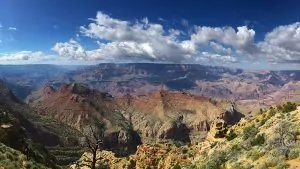Best Time to Visit
Learn about the best time to visit Grand Canyon based on what activities you'd like to do.
Updated: 10/31/22
There are several factors to take into account when deciding when to visit the Grand Canyon. The first is weather, and we’ve used that as a determining metric in our advice below. Second is crowds – how crowded of an environment are you willing to tolerate and still enjoy? And finally, the activities you’re interested in doing at the Canyon will affect when you should visit.
Below, we’ve categorized the “when to go” question based on what you want to do, and we’ve used multiple secondary variables including weather and crowds, to give the best advice possible.
WEATHER AND TEMPERATURES
The Grand Canyon spans roughly 300 miles in length and over a mile in depth. The depth especially has a profound effect on the climates and temperatures inside and on the rims of the Canyon. At the bottom of the Canyon, at an elevation of roughly 2500 feet (the elevation of Tucson) is a very arid, hot desert. The rims, however, (which are at elevations of 7000-8000 feet) are mountainous ecosystems consisting of pine and aspen forests with four solid seasons, plenty of snow in the winter, and intense thunderstorms in the summer. This reality forces guests to sometimes pack for multiple seasons and weather conditions. Even if you are planning on spending most of your time inside the canyon, you will start at higher elevation and may need gear/clothing for the start and finish of your hike that you possibly won’t need in the canyon.
Taking climate and weather into account is important when deciding when to visit the Grand Canyon. Throughout winter and much of spring, the trails (and sometime roads) are covered in ice. During this time of year you will probably need crampons or microspikes for your shoes. Much like tire chains for your car, these devices comprised of small chains, rubber, and spikes give you extra traction on ice and snow. Believe us, it only takes a small section of ice on the trail to be glad you add the extra gear. Grand Canyon trails are often steep and during the winter and spring when temperatures are above freezing during the day but freezing at night, the ice will become slicker as a layer of water forms on the surface, then freezes at night. Hypothermia is also a risk when visiting the Grand Canyon in winter, spring, and fall just as heat exhaustion and heat stroke are risks in summer. All of these conditions can be dangerous and hypothermia and heat stroke can be serious or fatal. You can read more about them on our visitor guide to know what to look for and what to do if you or one of your party exhibits symptoms of one of these conditions. Guests should also be aware that extreme heat in summer and snow storms or white outs in the winter can bring virtually all activities in the area to a screeching halt. It is very important to check the weather before you book you trip and before you leave on your trip to know what conditions you should expect. You can read more about the weather in each month in the park on our monthly pages.
SOUTH RIM, PHANTOM RANCH: AVERAGE HIGHS, LOWS AND PRECIP
| Month | South Rim | Phantom Ranch | Days of Precip | ||
| Avg Hi | Avg Lo | Avg Hi | Avg Lo | ||
| January | 44°F (7°C) | 18°F (-8°C) | 58°F (3°C) | 38°F (14°C) | 5 Days |
| February | 48°F (9°C) | 18°F (-8°C) | 64°F (18°C) | 42°F (6°C) | 5 Days |
| March | 55°F (13°C) | 22°F (-6°C) | 72°F (22°C) | 47°F (8°C) | 6 Days |
| April | 61°F (16°C) | 26°F (-3°C) | 82°F (28°C) | 54°F (12°C) | 3 Days |
| May | 71°F (22°C) | 36°F (2°C) | 92°F (33°C) | 63°F (17°C) | 2 Days |
| June | 82°F (28°C) | 43°F (6°C) | 103°F (39°C) | 72°F (22°C) | 1 Days |
| July | 85°F (29°C) | 50°F (10°C) | 106°F (41°C) | 77°F (25°C) | 5 Days |
| August | 82°F (28°C) | 49°F (9°C) | 103°F (39°C) | 74°F (23°C) | 6 Days |
| September | 76°F (24°C) | 43°F (6°C) | 96°F (35°C) | 69°F (21°C) | 4 Days |
| October | 65°F (18°C) | 33°F (1°C) | 83°F (28°C) | 58°F (14°C) | 3 Days |
| November | 52°F (11°C) | 24°F (-4°C) | 68°F (20°C) | 46°F (8°C) | 3 Days |
| December | 45°F (7°C) | 18°F (-8°C) | 58°F (14°C) | 38°F (3°C) | 4 Days |
BEST TIME OF YEAR FOR SIGHTSEEING
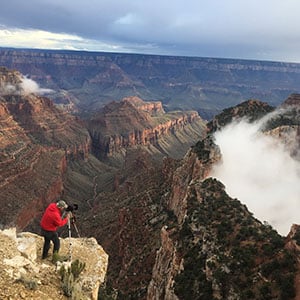 If you’re mainly wanting to sightsee, you will most likely be staying either at the South or the North Rim. The North Rim is closed from early November through May 15, but the South Rim is open year round. Summer is the best time of year to sightsee at the Canyon. High temperatures are often in the 80s, and afternoon rain showers in July, August, and September cool things down beautifully and create dramatic skies and views over the Canyon’s sheer depths. Another way to avoid the heat is to get up for sunrise or stay out for sunset as the light at these times paint amazing shades of amber, crimson, and gold on the canyon’s already colorful walls. These times gives you great opportunities for seeing some of the park’s most iconic overlooks as well as let you escape the heat and some of the crowds.
If you’re mainly wanting to sightsee, you will most likely be staying either at the South or the North Rim. The North Rim is closed from early November through May 15, but the South Rim is open year round. Summer is the best time of year to sightsee at the Canyon. High temperatures are often in the 80s, and afternoon rain showers in July, August, and September cool things down beautifully and create dramatic skies and views over the Canyon’s sheer depths. Another way to avoid the heat is to get up for sunrise or stay out for sunset as the light at these times paint amazing shades of amber, crimson, and gold on the canyon’s already colorful walls. These times gives you great opportunities for seeing some of the park’s most iconic overlooks as well as let you escape the heat and some of the crowds.
Winter months can be cold, windy, and snowy on the rims, which can make sightseeing difficult and uncomfortable. However, for those willing to brave the cold, winter adds an entirely new aspect to the canyon as white snow hangs on each ledge of red and orange rock, giving the depths of the canyon an almost ethereal appearance. While winter sometimes can bring majestic views of snow-covered rims with deep colors in the canyon, it can also bring whiteouts and storms that block your view altogether. Sightseeing of the canyon loses it appeal when you can only see 20 feet ahead of you before snow and clouds obscure your view. Spring and fall are often beautiful times to sightsee but it can still be cold with late or early snow storms, whipping winds, and white outs.
While the Grand Canyon is many things, it is not a destination for fall colors as most of the trees on the rims are evergreens and do not lose their leaves. A few of the trees (especially on the North Rim) are Aspens and will change to bright yellow or orange in September and October, but these are scarce and can lose their color quickly with the first winter storm. Spring does bring some wildflowers to the park, but visitors may have to track them down in certain areas instead of being blindsided by them all across the park. Overall then, summer is the best time to sightsee at the Grand Canyon while the other seasons bring some specific opportunities along with risk of limitations as well.
BEST TIME OF year FOR HIKING AND BACKPACKING
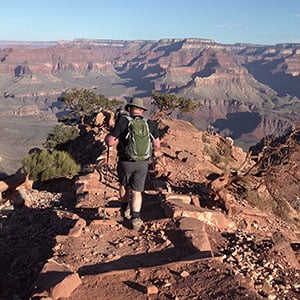 If you’re going to hike or backpack in the Grand Canyon, it means you’ll be going below – and often far below – the pine-forested rims. As you descend, the Canyon turns to desert and warms quickly. At the very bottom of the Canyon the high temperatures in summer are often well above 100 degrees Fahrenheit in the shade. In addition to the intense heat, the elevation on the rims and in the canyon itself can caused strained breathing for guests that are used to living at or close to sea level. The elevation also makes the air very dry, often making it feel hotter than it is and sometimes causing cracking skin on hands and feet. Summers are very intense in the canyon itself and many guests do not understand how intense the heat will be inside the canyon until they have already descended from the rims with too little water or an overly ambitious hiking plan. For these reasons, we do not recommend hiking to the bottom of the Canyon or backpacking in the summer unless you are with a hiking guide company or are very experienced with desert hiking. This environment is hostile and not to be trifled with.
If you’re going to hike or backpack in the Grand Canyon, it means you’ll be going below – and often far below – the pine-forested rims. As you descend, the Canyon turns to desert and warms quickly. At the very bottom of the Canyon the high temperatures in summer are often well above 100 degrees Fahrenheit in the shade. In addition to the intense heat, the elevation on the rims and in the canyon itself can caused strained breathing for guests that are used to living at or close to sea level. The elevation also makes the air very dry, often making it feel hotter than it is and sometimes causing cracking skin on hands and feet. Summers are very intense in the canyon itself and many guests do not understand how intense the heat will be inside the canyon until they have already descended from the rims with too little water or an overly ambitious hiking plan. For these reasons, we do not recommend hiking to the bottom of the Canyon or backpacking in the summer unless you are with a hiking guide company or are very experienced with desert hiking. This environment is hostile and not to be trifled with.
The shoulder seasons of spring and fall are much kinder to the hiker and backpacker although they do come with some drawbacks. The weather in the canyon smooths out to be nice for hiking and the abundant water in the spring allows for longer trips. The shoulder seasons are probably the most popular for backpacking however, so getting a permit and finding part of the canyon that you can have to yourself can be more difficult.
Winter is a favorite among guides who guide tours to the canyon all year because they can escape the crowds and have it mostly to themselves. Of course, you must brave the winter weather at the rims before you can descend into the canyon, but the floor of the canyon often has wonderful temperature with mild days and cool nights perfect for hiking. The colder weather at the rim will be a blessed relief when hiking out of the canyon as the temperature cools while you become warmer from the exercise and steep trails. The possibility of winter storms closing roads and trails is a chance you take when backpacking or hiking in the Grand Canyon in winter. It is well worth it though for the temperatures in the canyon and reservations at some of the best hotels during the off season, including Phantom Ranch – a quaint and rather primitive lodge (although with running water and heat) and cabins that are much sought after during other parts of the year.
Best time of year to visit the north rim
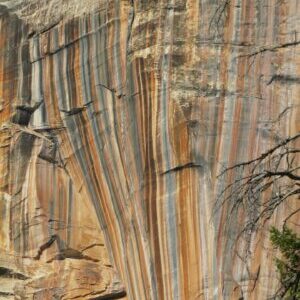 For many repeat Grand Canyon visitors, the North Rim is on their bucket list to experience. This much more remote section of the park stands in contrast to the civilized and rather touristy South Rim with only one lodge and one campground open from mid-May through mid-October. For this reason, most people who visit the North Rim go during this time. In fact, the road to the North Rim is closed from November to May due to snow. Even though the summer is when most of the visitors come to the North Rim, it is still far less busy than the South Rim, receiving only about 15% of all the Park’s visitors. All the same reasons for going to the South Rim in the summer vs early fall or late spring apply to the North Rim as well. You will probably encounter snow later in the spring and early in the fall at the North Rim and reduced crowds earlier than on the South Rim.
For many repeat Grand Canyon visitors, the North Rim is on their bucket list to experience. This much more remote section of the park stands in contrast to the civilized and rather touristy South Rim with only one lodge and one campground open from mid-May through mid-October. For this reason, most people who visit the North Rim go during this time. In fact, the road to the North Rim is closed from November to May due to snow. Even though the summer is when most of the visitors come to the North Rim, it is still far less busy than the South Rim, receiving only about 15% of all the Park’s visitors. All the same reasons for going to the South Rim in the summer vs early fall or late spring apply to the North Rim as well. You will probably encounter snow later in the spring and early in the fall at the North Rim and reduced crowds earlier than on the South Rim.
For most visitors, it is best to visit the North Rim when the road and services are open. However, the adventurous (and skilled) backpacker can reach the North Rim while the road is close throughout the year by hiking Rim to Rim to Rim and backcountry camping in the canyon and on the rim. This hike from the South Rim to the North Rim (21 miles) and back to the South Rim (another 21 miles) is on many backpackers’ bucket lists but is not for the faint of heart. The trek affords you the opportunity to visit this famous and breathtaking area while it is inaccessible to most of the world. Especially in winter, you will find the North Rim hushed with snow and you may very well find yourself without company as you camp in one of the most remote places in the US. Of course, if you hike to the North Rim in winter or any time the road is closed, you are likely to run into snow. While early fall and late spring have less snow and do not require intense winter gear, backpackers should be prepared with microspikes and four season tents for much of the hiking season. This is a fantastic way to experience solitude and beauty on the North Rim but do not attempt this unless you are an experienced winter camper or are going with a guiding company to ensure your safety and enjoyment.
Best time of year to visit with kids
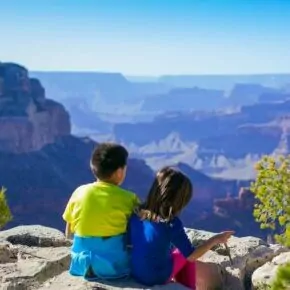 Visiting the Grand Canyon with kids is well worth the work it will take as your little ones are not likely to forget the experience of seeing this world wonder for the first time. However, there are some things you need to take into consideration when bringing kids to the park. Everything that applies for each season applies for those bringing kids to Grand Canyon; if anything all these factors are amplified. Kids are more likely to become susceptible to the cold in the winter and the heat in the summer. This means that parents need to be extra careful and make sure the kids are dressed properly for the weather. Do your kids have crampons for winter? Can they carry enough water for themselves in summer or will you have to carry it for them? The shoulder seasons are great to visit the park with kids, but kids are typically in school which makes it difficult to take a longer vacation in spring and fall.
Visiting the Grand Canyon with kids is well worth the work it will take as your little ones are not likely to forget the experience of seeing this world wonder for the first time. However, there are some things you need to take into consideration when bringing kids to the park. Everything that applies for each season applies for those bringing kids to Grand Canyon; if anything all these factors are amplified. Kids are more likely to become susceptible to the cold in the winter and the heat in the summer. This means that parents need to be extra careful and make sure the kids are dressed properly for the weather. Do your kids have crampons for winter? Can they carry enough water for themselves in summer or will you have to carry it for them? The shoulder seasons are great to visit the park with kids, but kids are typically in school which makes it difficult to take a longer vacation in spring and fall.
Each family will have to decide what their kids can handle as this will also impact what time of year is best to go. If you think your little ones aren’t up for anything but sightseeing and maybe some of the museums, then summer is great because the weather will likely be clear and you won’t be too affected by the heat if you’re not hiking below the rim. There is, however, one great reason to take your kids to Grand Canyon in the winter: the Grand Canyon Railway. This train ride from the nearby town of Williams is great anytime of year as they typically have “outlaws” galloping on horses alongside the train which then board the train for a fun version of a hold up that usually ends with the actors giving the kids bullet casings. But in November and December, the railroad becomes extra special for kids as the train runs at night and is transformed into the Polar Express. Complete with cookies, hot chocolate, and a visit from Santa, the kids are sure to love this Christmas themed train ride. Make sure to get your reservations in advance as this activity is very popular and can fill up.
Ultimately, each family will have to decide when is best to take their kids to the Grand Canyon. Most will chose summer because the kids are out of school and they aren’t planning on do very much hiking. But backpacking trips and more adventurous sports such as rafting and hiking are great if you can get away during other months and think your kids are ready for some adventures. Don’t hesitate to choose the Grand Canyon in one of the shoulder seasons or even in winter for your family vacation.
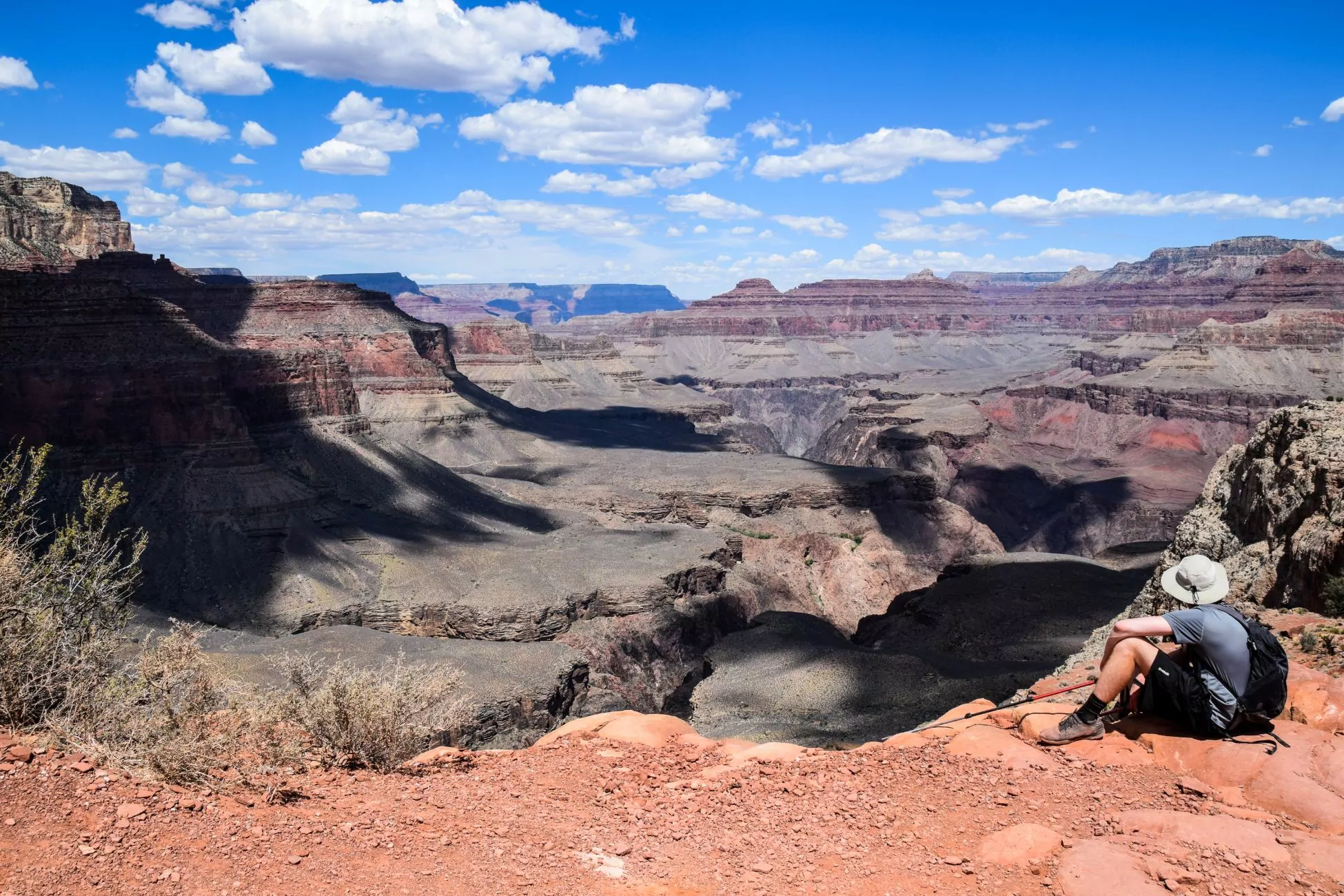
BEST TIME OF YEAR FOR RAFTING
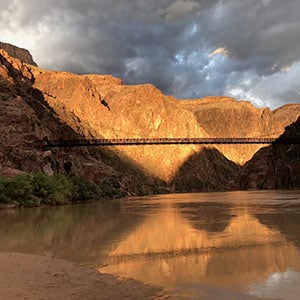 The Colorado River runs through the hottest, driest portion of the Canyon (the bottom), but its waters flow out of the bottom of Lake Powell and remain a frosty 52-ish degrees Fahrenheit through the Canyon. So getting soaked in the rapids can be shockingly cold or wonderfully refreshing, depending on the time of year. Truth be told, however, that even when the air temperature is 100 degrees or more, the water will feel very cold. In fact, because of the greater temperature difference, the water will feel colder in the summer. But getting splashed (although maybe not soaked) can be lovely when the the floor of the canyon is searing with heat. The best time for rafting the Grand Canyon is April through October. Since these are the only months that tours are available, they are the only options for most visitors. The shoulder months (April and October mainly) can be quite chilly, but feasible.
The Colorado River runs through the hottest, driest portion of the Canyon (the bottom), but its waters flow out of the bottom of Lake Powell and remain a frosty 52-ish degrees Fahrenheit through the Canyon. So getting soaked in the rapids can be shockingly cold or wonderfully refreshing, depending on the time of year. Truth be told, however, that even when the air temperature is 100 degrees or more, the water will feel very cold. In fact, because of the greater temperature difference, the water will feel colder in the summer. But getting splashed (although maybe not soaked) can be lovely when the the floor of the canyon is searing with heat. The best time for rafting the Grand Canyon is April through October. Since these are the only months that tours are available, they are the only options for most visitors. The shoulder months (April and October mainly) can be quite chilly, but feasible.
Tour companies occasionally open in March, but this month is especially cold for rafting. While the crowds will not be as much of a nuisance and you might get a cheaper rate in April or October due to the off season, the frigid waters are not for the faint of heart and it is the off season for a reason. May and September are really the prime times to go and they are simply beautiful. The slightly less than summer heat makes being in the canyon bearable while still being warm enough to enjoy being on the river. Of course, this is the time when everyone else will be wanting to go, so make sure to get reservations in advance. June is very hot and dry and even being on the water can still be stifling in the canyon with the water feeling icy and the air feeling like an oven. But many people still go rafting and enjoy it in June.
July and August are also good months for the rapids, but they are are monsoon months so thunderstorms, heavy rains, and flooding are very possible. This could make your trip more difficult than you thought or force your guide to change routes based on water levels, side hikes, and afternoon thunderstorms. As one of the most popular activities in the park, rafting is a must-do for many Grand Canyon goers and you can learn more about smooth water and white water rafting trips here.
BEST TIME OF YEAR TO AVOID CROWDS
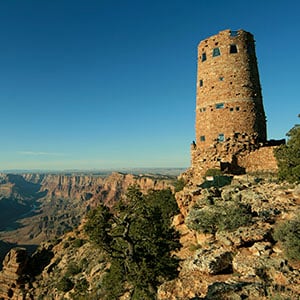 Without a doubt the best time to avoid crowds at Grand Canyon is winter: December, January and February. You may at first think “Yeah, I don’t want to be there in the winter either!” But it’s an excellent time of year to visit for other reasons. For one, winter hiking can be perfect. As you descend, the temperatures steadily rise, until at the bottom of the Canyon winter highs are often in the 60s or even 70s. Another reason is the stunning views of snow contrasting with the other colors in the canyon. Winter storms and blue skies can set the stage for absolutely stunning photography. Reservations in the park, even at the famed Phantom Ranch on the canyon floor, are much easier to come by and much less expensive than in peak season as you are not competing with throngs of other visitors. Yes, winters can be cold, snowy, and come with some dangers while hiking such as ice on the trails and the threat of hypothermia, but the desert environment at the bottom of the canyon makes winter warmer than it would be elsewhere and a pleasant respite from the cold at the rims. That is, if you can get down from the rims; the only way to do this is on foot.
Without a doubt the best time to avoid crowds at Grand Canyon is winter: December, January and February. You may at first think “Yeah, I don’t want to be there in the winter either!” But it’s an excellent time of year to visit for other reasons. For one, winter hiking can be perfect. As you descend, the temperatures steadily rise, until at the bottom of the Canyon winter highs are often in the 60s or even 70s. Another reason is the stunning views of snow contrasting with the other colors in the canyon. Winter storms and blue skies can set the stage for absolutely stunning photography. Reservations in the park, even at the famed Phantom Ranch on the canyon floor, are much easier to come by and much less expensive than in peak season as you are not competing with throngs of other visitors. Yes, winters can be cold, snowy, and come with some dangers while hiking such as ice on the trails and the threat of hypothermia, but the desert environment at the bottom of the canyon makes winter warmer than it would be elsewhere and a pleasant respite from the cold at the rims. That is, if you can get down from the rims; the only way to do this is on foot.
If you can’t make it (or simply refuse to go) in the winter, spring and fall are better than summer for avoiding crowds. Because these are the best times for activities such as rafting, backpacking, hiking, and many other outdoor activities, you will be sharing the park with those who are coming to participate in more than just sightseeing. But these crowds won’t seem like much when compared to summer. Watch out for the crowds in late March and early April though, as this park is a popular spring break destination. Summer is, of course, the busiest season. Schools are out of session, many people choose to take vacation time at work, and travel is overall easier. While the Grand Canyon is famed for it’s intensely dry heat, this does not keep the crowds away and you will not have the park to yourself by choosing to brave the heat. Swarms of people come to the park in summer, but there are a few ways you can avoid the crowds. The best way is to go to the North Rim, a much more remote and less touristy area than the South Rim. Less than 15% of the park’s visitors come to the North Rim and its solitude is a blessed relief from the busyness of the south side of the canyon. While it is only 21 miles to get to the North Rim if you walk through the canyon (not recommended in summer unless you’re with a guiding company or are an experienced desert backpacker), it’s over 225 miles to drive to the North Rim as you have to go around the canyon.
Finally, going on a less popular hike can also help you escape the crowds. Explore some of the lesser known areas such as West Rim or the Desert View Watchtower near the eastern entrance to the park. While you are probably not going to find any location that you have all to yourself, you can find some relief from the crowds through exploration of lesser known places in the park.
best time to see wildlife
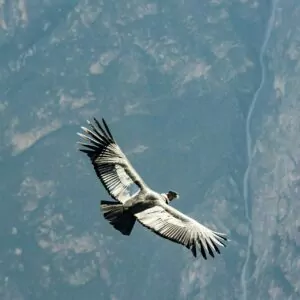 The Grand Canyon is full of biodiversity in its wildlife, largely due to the fact that it contains two distinct emviorments: the desert canyon floor and the conifer-forested rims. Wildlife is active all throughout the year, but each season brings something different to the park’s wildlife. Throughout all the seasons, however, the best time of the day to see wildlife is at dawn or dusk when the crowds– and the heat in summer– have died down. Most wildlife is least active in winter. The reptiles and amphibians will be hibernating to wait out the colder weather, and some of the park’s larger animals will be less active and less likely to be seen. Coyotes and bobcats can still be seen in winter and lucky visitors might get to see mountain lion tracks in the snow. Bighorn sheep, mule deer, and elk all also stay in the park during the winter and the endangered California condor is still often seen in the snowy months. The snow can be as asset to wildlife viewers as it preserves animals tracks better than dirt and might allow you to get a glimpse of — or at least of the evidence– of some of the park’s more elusive creatures.
The Grand Canyon is full of biodiversity in its wildlife, largely due to the fact that it contains two distinct emviorments: the desert canyon floor and the conifer-forested rims. Wildlife is active all throughout the year, but each season brings something different to the park’s wildlife. Throughout all the seasons, however, the best time of the day to see wildlife is at dawn or dusk when the crowds– and the heat in summer– have died down. Most wildlife is least active in winter. The reptiles and amphibians will be hibernating to wait out the colder weather, and some of the park’s larger animals will be less active and less likely to be seen. Coyotes and bobcats can still be seen in winter and lucky visitors might get to see mountain lion tracks in the snow. Bighorn sheep, mule deer, and elk all also stay in the park during the winter and the endangered California condor is still often seen in the snowy months. The snow can be as asset to wildlife viewers as it preserves animals tracks better than dirt and might allow you to get a glimpse of — or at least of the evidence– of some of the park’s more elusive creatures.
Spring and fall are excellent times for wildlife viewing as it is not yet too hot for the animals or for you. Keep an eye out for wildlife foraging on some of the budding plants that come up in the spring. Javelina, small, pig-like animals also known as the collared peccary, have been known to even eat cactus at times. Another distinct resident of the park is the ringtail. Sometimes called “the cutest animal you’ve never seen,” this creature is closely related to raccoons but is often called a ringtail cat. They are strictly nocturnal, but are often seen around Phantom Ranch at night and sometimes will invade buildings searching for food.
Summer is the time when you can see many of the reptiles and birds in the park while many of the bigger animals retreat during the day to escape the heat. The park is home to a variety of venomous rattlesnakes as well as collard lizards and the famous Gila Monster, a large orange and black lizard that is one of the few venomous lizards in North America. Although a bite from the gila monster is not fatal to humans, it can be very painful so it’s best to give these animals a wide berth. The California condors are one of the most sought after wildlife sightings in the park. Brought back from the brink of extinction through captive breeding programs, the California condor has had an epic recovery story through conservation and efforts to restore their habitat. The largest bird native to the Americas with a wing span that can reach up to 9.5 feet, these birds are truly a sight to behold. Often confused with turkey vultures while in flight, condors are larger and have a much smoother flight pattern than turkey vultures that often appear “wobbly” when they fly. Mostly scavengers and the land equivalent of the sea-born albatross, condors rarely roost in the same place more than one night unless they have a nest and can travel many miles in a single day. These birds are truly majestic and remarkable to see after such a long recovery period which in many ways is still in progress.
Wildlife is simply stunning in the Grand Canyon and you won’t regret taking some time to look for these amazing creatures no matter what season you visit in.
Best time of year for photography
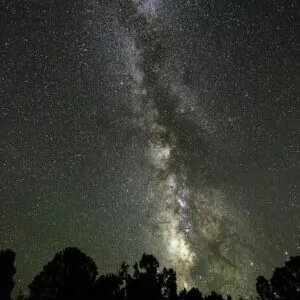 The Grand Canyon is great for photography any time of year as the beauty of the place makes it almost impossible to take a bad picture. If photography is your biggest activity, then when you go will depend on what you want to shoot. Winter is a fantastic time to get shots of the canyon hushed with snow and without people in the foreground. Of course, you run the risk of not being able to see anything if there is a white out snow storm, but the storm will leave the red and orange rocks in the canyon edged with white that will make for ethereal photos.
The Grand Canyon is great for photography any time of year as the beauty of the place makes it almost impossible to take a bad picture. If photography is your biggest activity, then when you go will depend on what you want to shoot. Winter is a fantastic time to get shots of the canyon hushed with snow and without people in the foreground. Of course, you run the risk of not being able to see anything if there is a white out snow storm, but the storm will leave the red and orange rocks in the canyon edged with white that will make for ethereal photos.
If you’re looking to do night sky photography, then summer is the best time to go, typically around May, June, or September. Weather is least likely to get in your way during these months as monsoon season is in July and August where you might run into clouds in the afternoons and at night. These months will also be the warmest to be out at night and will probably be a blessed relief from the heat whereas winter or even shoulder season night photography can be bitterly cold. If you’re looking to do wildlife photography, then spring or fall would probably be your best options to balance fewer crowds (that won’t scare the animals as much) and the absence of intense heat that would prevent you from being outside all day. The shoulder seasons also bring out the reptiles and amphibians that were in hibernation during the winter. The Grand Canyon truly is spectacular for photography any time of year you go, but make sure to know what to expect from the weather and that you are prepared for the photos you want to take.
JOIN A GUIDED HIKING ADVENTURE
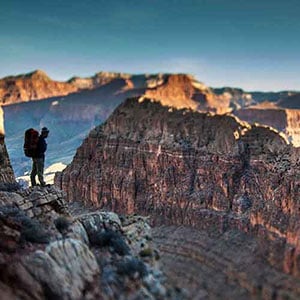 Grand Canyon National Park is home to some of the most unique and spectacular hiking vacations in the world. Wildland Trekking offers trips with stunning views, geologic history, and incredible hiking and backpacking for visitors who want to have an active, adventurous experience.
Grand Canyon National Park is home to some of the most unique and spectacular hiking vacations in the world. Wildland Trekking offers trips with stunning views, geologic history, and incredible hiking and backpacking for visitors who want to have an active, adventurous experience.
Guided Grand Canyon treks include permits, local transportation (excluded on certain tours), meals, gear, risk management systems and professional guides, allowing guests to make the most of their visit to the Canyon, focus 100% on enjoying their experience, and do it all with an increased level of safety and comfort.
GRAND CANYON ADVENTURE TOURS
- GUIDED BACKPACKING ADVENTURES: these are for people interested in an authentic adventure deep in the Canyon’s wilderness.
- HORSE-ASSISTED TRIP: on this trip to the bottom of the Canyon, guests hike with light day packs and camp near the Colorado River.
- PHANTOM RANCH TOURS: this tour (limited dates) goes to the bottom of the Canyon where we sleep 1 or 2 nights in the Phantom Ranch Lodge 5 minutes from the Colorado River. Showers, A/C, heat…etc.
- ALL-INCLUSIVE HIKING PACKAGES: inn-based and camping-based hiking packages provide all-around hiking experiences of the Grand Canyon.
- DAY HIKE TOURS: maximize your day at Grand Canyon on a fully guided, award-winning hiking tour on one of the Park’s best trails.
The Mt. Rainier Inn trip with Wildland was perfect. The Inn was comfortable; the guide was an expert in his field; the pacing was just right to accommodate all those on the trip; the scenery was ideal. If you can go please do.





